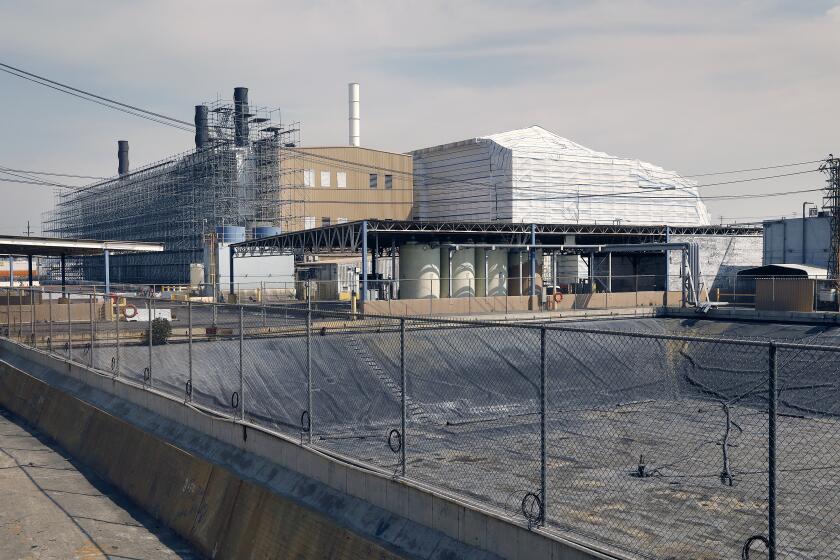
- Share via
California’s largest and most expensive environmental cleanup has failed to properly remove lead pollution from some homes and neighborhoods near a notorious battery recycler in southeast Los Angeles County, leaving residents at continued risk, a Times investigation shows.
Six years after the California Department of Toxic Substances Control embarked on a massive remediation effort around the shuttered Exide plant, numerous homes targeted for cleanup have been left with concentrations in excess of state health standards.
In findings shared exclusively with The Times, researchers at USC and Occidental College reported that they had tested surface soil from the yards of 93 remediated homes and found 73 had at least one sample with lead concentrations over the California health threshold of 80 parts per million. They also found that 22 of the homes had at least one sample that tested over 400 parts per million, the federal limit.
The high lead concentrations have raised serious questions about the department’s oversight of the $750-million project — as well as its commitment to making these predominantly Latino and historically underserved neighborhoods safe from a brain-damaging metal.
The Times investigation into the cleanup also found:
* Contractors have failed to meet the state standards in more than 500 of 3,370 cleaned properties near the shuttered Vernon plant, according to toxics agency records. Guidelines call for contractors to remove soil until the lead concentration is below 80 parts per million, or to dig down 18 inches, before putting clean soil on top.
* Contractors have violated environmental regulations designed to protect residents from the potent neurotoxin during the cleanup. Violations include allowing toxic dust to migrate into neighboring yards and amassing lead-saturated soil on the same block as a Huntington Park preschool that was in session, according to citations issued by the South Coast Air Quality Management District.
* The state has yet to offer a plan for cleaning lead-contaminated parkways that lie just beyond the sidewalks in affected neighborhoods — areas that have resulted in at least one documented case of lead poisoning.
* Los Angeles County prosecutors said they are investigating the possible illegal dumping of contaminated soils taken from the cleanup site and deposited in a nonhazardous waste landfill in Azusa.
Officials with the state Department of Toxic Substances Control have acknowledged missteps, but say many of those issues have been addressed. They say the agency is forging ahead with work to remove lead from another 1,500 properties by 2025.
“We don’t claim to have gotten everything right on this critical project,” said Meredith Williams, the agency’s director since 2019. “There was no blueprint based on similar projects that could inform our work. ... I’m not sure any state department or agency anywhere in the country would have gotten there.”
Not everyone in the community agrees.
“I’m just disgusted. Just disgusted with the whole process,” said Msgr. John Moretta, pastor of Resurrection Catholic Church in Boyle Heights, who has led his community in fighting pollution in the neighborhood for decades. He called the state’s oversight of Exide and the cleanup “disgraceful.”
Los Angeles County Supervisors Hilda Solis and Janice Hahn, who represent the affected communities, are now calling for an audit to explain why residents are still living with lead.
“These people thought that they had a clean bill of health and, in fact, they don’t,” Hahn said. “We will not be happy until we know that these homes have been cleaned up — for good.”
Added Los Angeles Mayor Karen Bass: “This community has suffered for so long, and a proper cleanup is long overdue.”
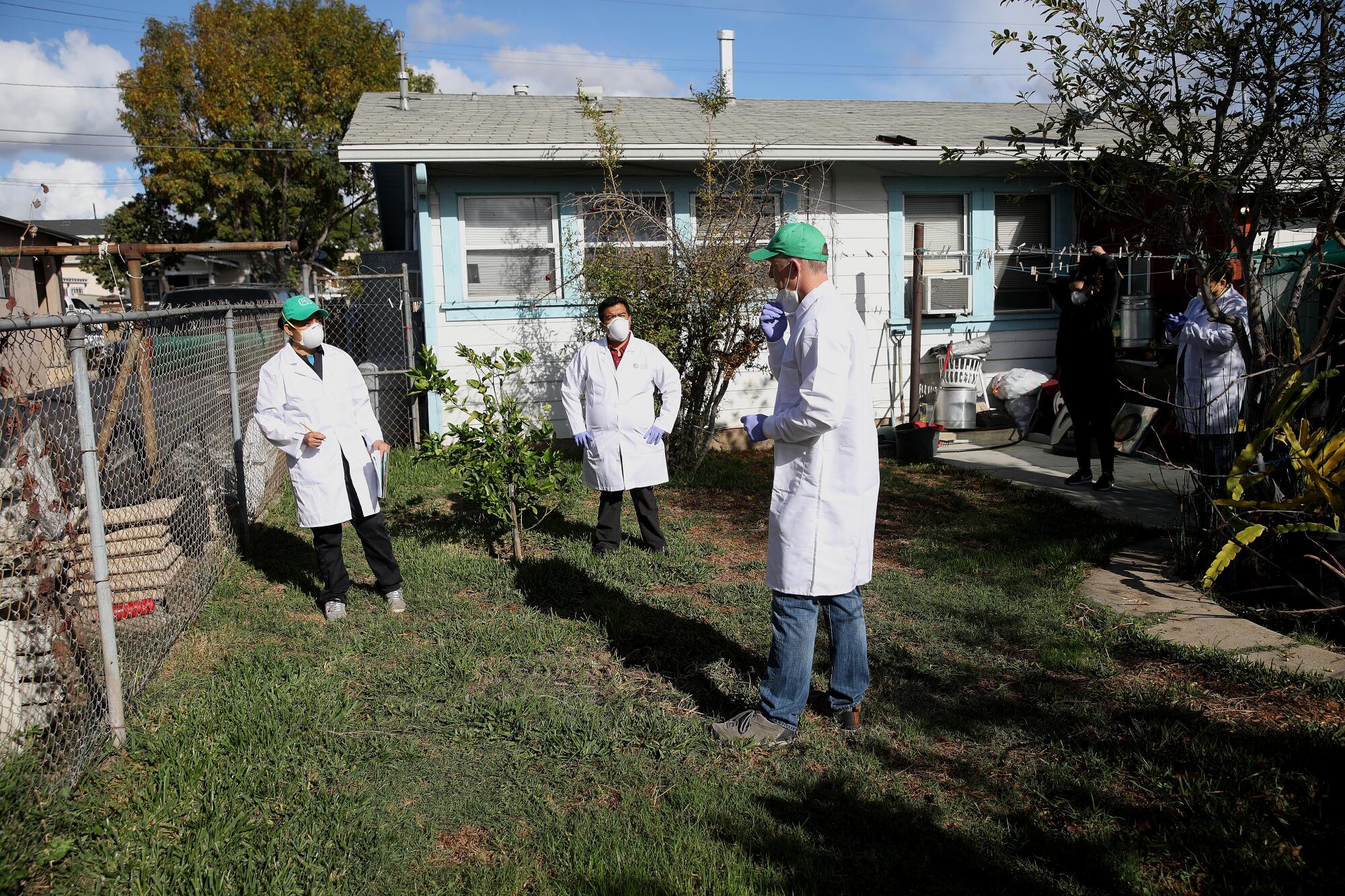
The enduring presence of lead has unnerved residents with young children, including Guadalupe Valdovinos, who has a 13-year-old daughter and a son who will turn 2 in March.
At her family’s home in unincorporated East Los Angeles, state-led soil testing found lead concentrations in her yard as high as 608 parts per million — more than seven times higher than California health standards.
Valdovinos said she had been looking forward to the remediaton that began in October 2019 so her daughter could play outside again. But when workers arrived, they refused to excavate the front yard, due to the presence of large agave plants, she said. They also balked at digging up a narrow strip of soil near the home’s fence-line, saying it wasn’t detailed in the cleanup plans.
Eventually, they did the work. But Valdovinos — who was so concerned about the toxic effects of lead that she had waited for her home to be remediated before having her second child — couldn’t shake her unease.
Last year, she asked scientists running a lead-testing initiative, Prospering backyards, to retest her property. They discovered a portion of her yard still contained soil with a lead concentration of 543 parts per million.
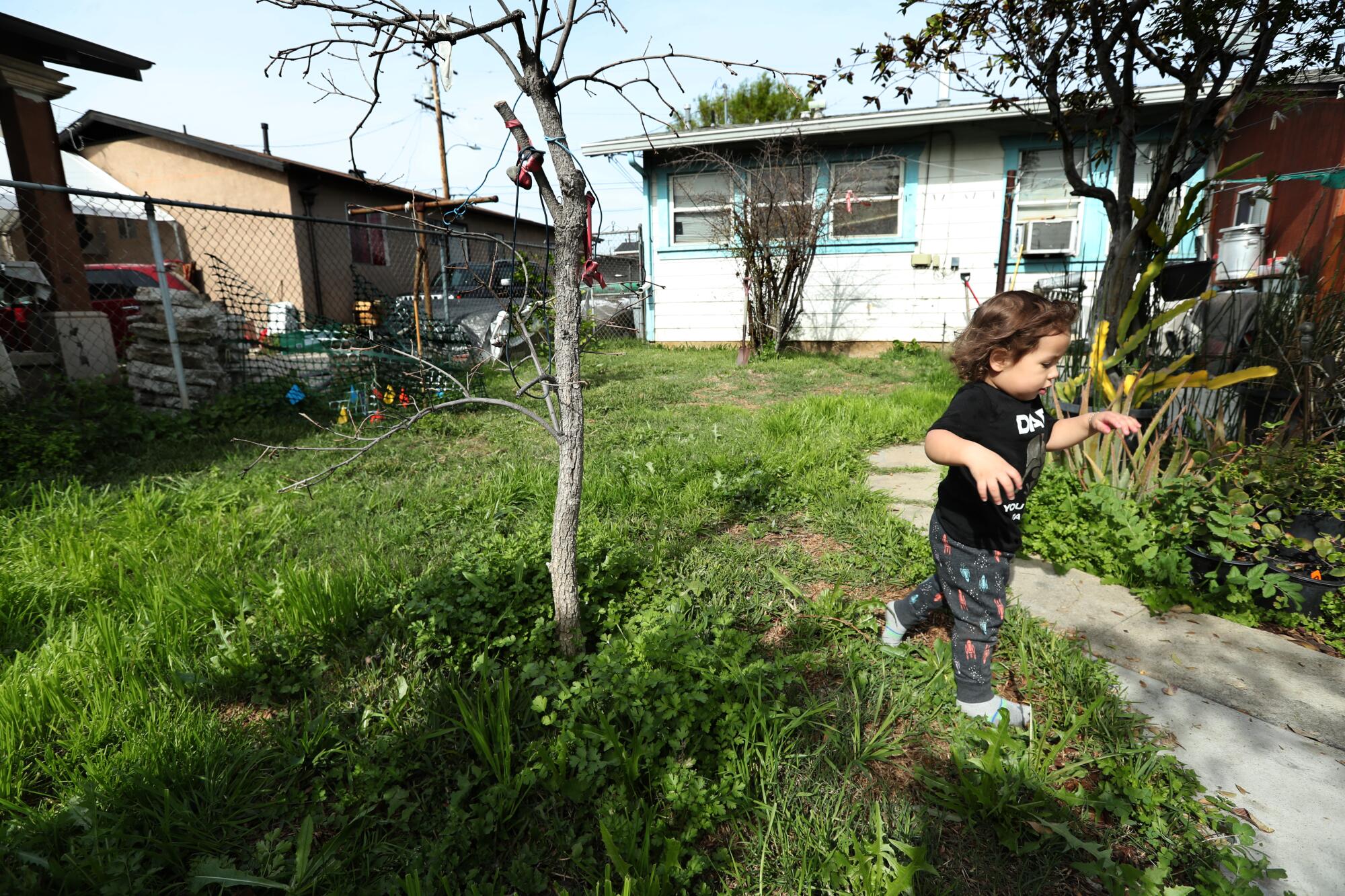
Now every day is an exercise in contamination control: Shoes are removed before coming indoors to avoid tracking in toxic dirt, floors and countertops are cleaned incessantly, the children are watched closely on the rare occasion they go outside to play.
“My daughter refuses to come out,” Valdovinos said. “She’s sad. She’s like, ‘Why don’t we just move, Mom?’ And I’m like, ‘We can’t take your grandparents. This is their home. They worked hard to transform it into what it is now and they’re proud of it.”
“She’s like, ‘Yeah, it’s pretty — but it’s full of lead.”
For nearly a century, the battery recycling plant had belched poisons such as lead and arsenic into the air. The toxins, according to state officials, blanketed the yards of thousands of homes in communities including Boyle Heights, East Los Angeles and Commerce.
Exide, which acquired the plant in 2000 and has since filed for bankruptcy, did not respond to a request for comment left with its attorney. The company had argued in the past that it was not responsible for lead contamination in the neighborhoods, and blamed other sources such as industrial facilities and lead-based paint.
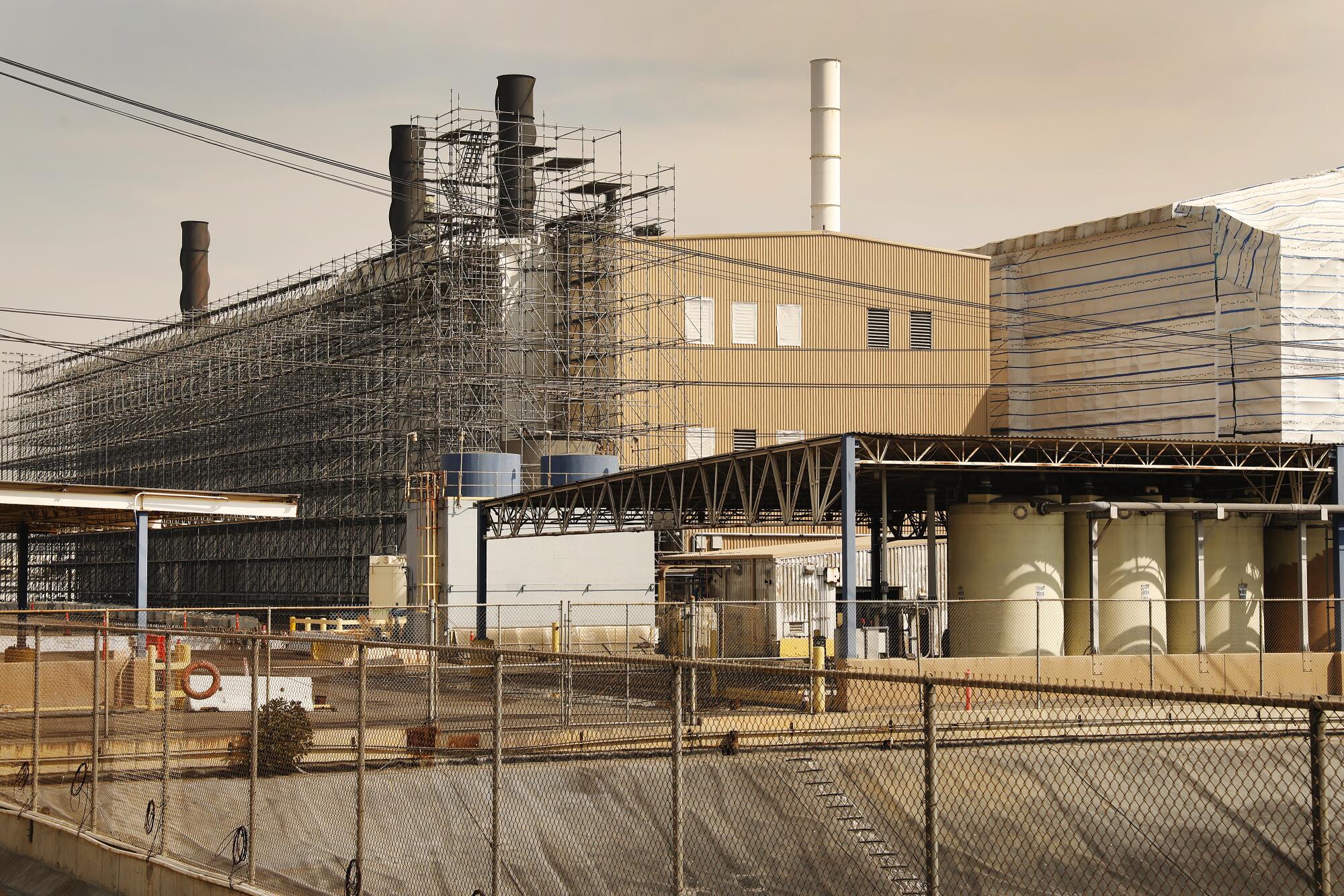
Even before modern environmental regulations were enacted in the 1970s, the plant’s operations became a source of outrage. In 1944, the Los Angeles County district attorney cited operators for releasing “poisonous, noxious … fumes, gasses or smoke,” according to news reports.
The plant did not obtain an operating permit, as required by the 1976 federal Resource Conservation and Recovery Act. California officials granted the plant an interim permit in 1981, on the promise that it would soon come into compliance with regulations.
It never did.
Unsettled: Exide | Video by Bethany Mollenkof and Spencer Bakalar
Year after year, the plant continued to operate without proper pollution control systems. And year after year, people complained to regulators that Exide was making them sick. Their pleas mostly fell on deaf ears — until 2013, when the South Coast Air Quality Management District revealed that more than 100,000 people near the plant faced an increased risk of cancer from arsenic emissions. That set off an uproar that eventually forced the plant to close amid threats of federal criminal prosecution in 2015.
Later, the toxics agency determined as many as 10,000 properties surrounding the plant could have been affected by Exide’s pollution based on state-ordered soil testing.
State leaders eventually committed to removing and replacing toxic soil, framing the massive cleanup as a measure of redress for neighborhoods subjected to decades of environmental degradation and government negligence.
“With this funding plan, we’re opening a new chapter that will help protect the community,” then-Gov. Jerry Brown said in 2016.
Nobody thought the work would be easy.
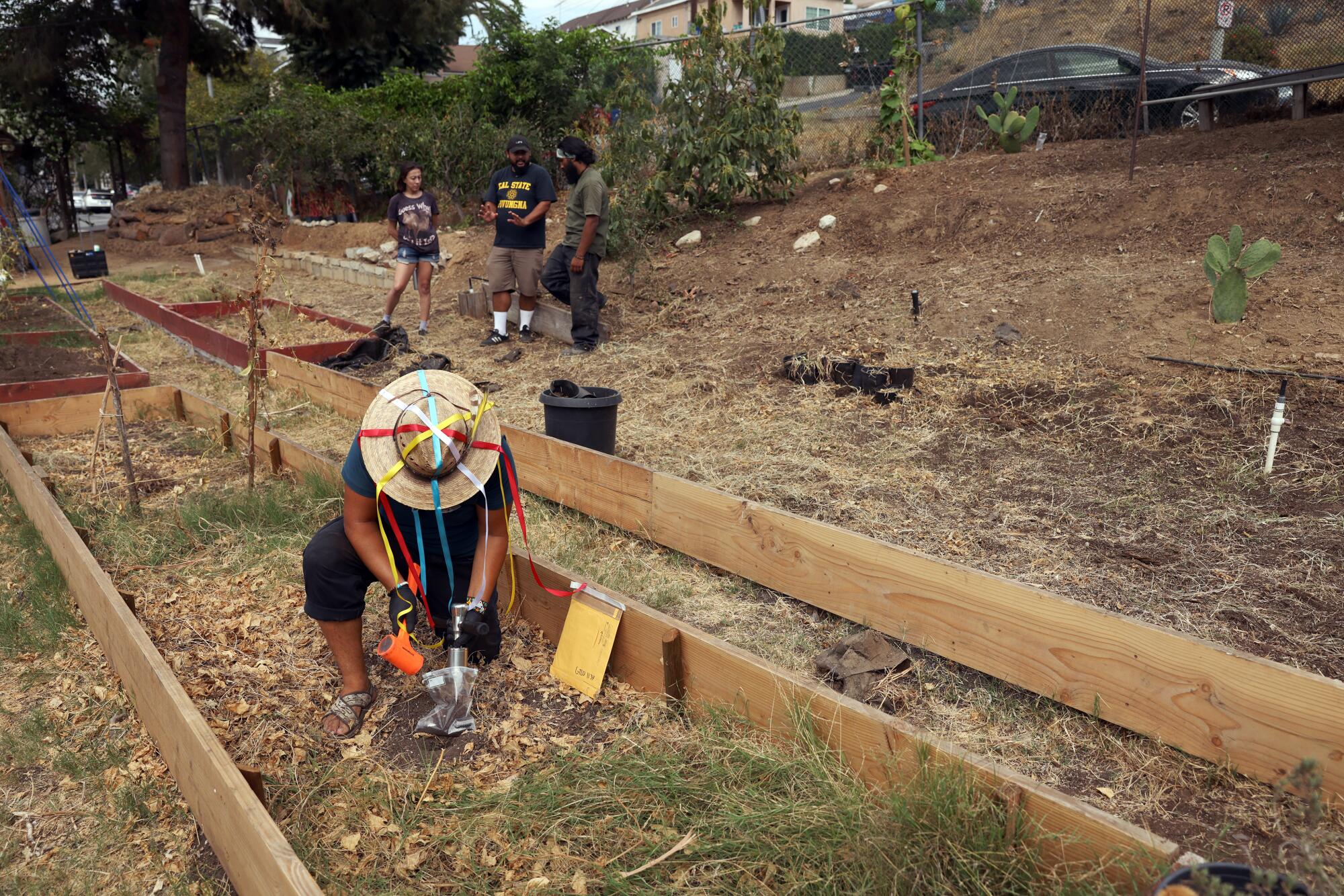
Crews would have to excavate and haul away hundreds of thousands of tons of contaminated soil from homes, parks, schools and childcare centers — and replace it with safe dirt.
So far, the state has spent more than $336 million and overseen the remediation of nearly 4,400 properties.
“Those people living in these homes should feel today safer than they were before. That’s the main message,” said Mehdi Bettahar, who has overseen the cleanup since 2019.
Yet some question whether that is true.
As the cleanup progressed, Jill Johnston, an associate professor of environmental health at USC, noticed that many residents were wary of enjoying their yards even after contaminated soil was replaced.
To alleviate concerns, Johnston and other researchers offered free testing to people whose homes had been cleaned.
What they found was not reassuring.
“It raises a lot of questions about how systematic the cleanup is in these homes,” Johnston said.
Asked for comment on the USC testing results, the Department of Toxic Substances Control said it needed more information.
“While the department has been made aware of USC’s sampling, we have not been given access to the full study and do not know which properties were sampled, where on the property the samples were taken, or how the samples were analyzed,” the agency said in a statement. “Those details will be critical to confirming a scientific apples-to-apples comparison and informing our ongoing work at the site.”
Problems have dogged the cleanup from the outset.

In 2020, the state auditor castigated the toxic substances agency for a slow pace of work and huge cost overruns. Despite assurances from the agency that the cleanup is back on track, an analysis of government records and numerous interviews with residents and former workers suggest the project is still struggling.
State remediation guidelines call for the removal of soil layers until the lead concentration drops to 80 parts per million or lower. If that can’t be achieved, crews should excavate to a depth of 18 inches, so that sufficient clean soil can be placed on top and prevent most contact with the neurotoxin.
But that did not occur in at least 559 of 3,370 properties, according to data The Times obtained through a public records request.
Officials insisted the failures posed no direct health risks because a covering of clean topsoil meant residents would not be exposed to lead unless the buried soil was unearthed. They also said that tree roots, pipes, cisterns or other buried objects made it impossible in some cases to dig down 18 inches.
The state’s work plan calls for further evaluation in cases where workers do not meet state objectives. But officials admitted at a public meeting this fall that that hasn’t happened.
“We have yet to revisit those sites to do the analysis,” Steven Hariri, Department of Toxic Substances Control project manager for the Exide residential cleanup, said on Nov. 17.
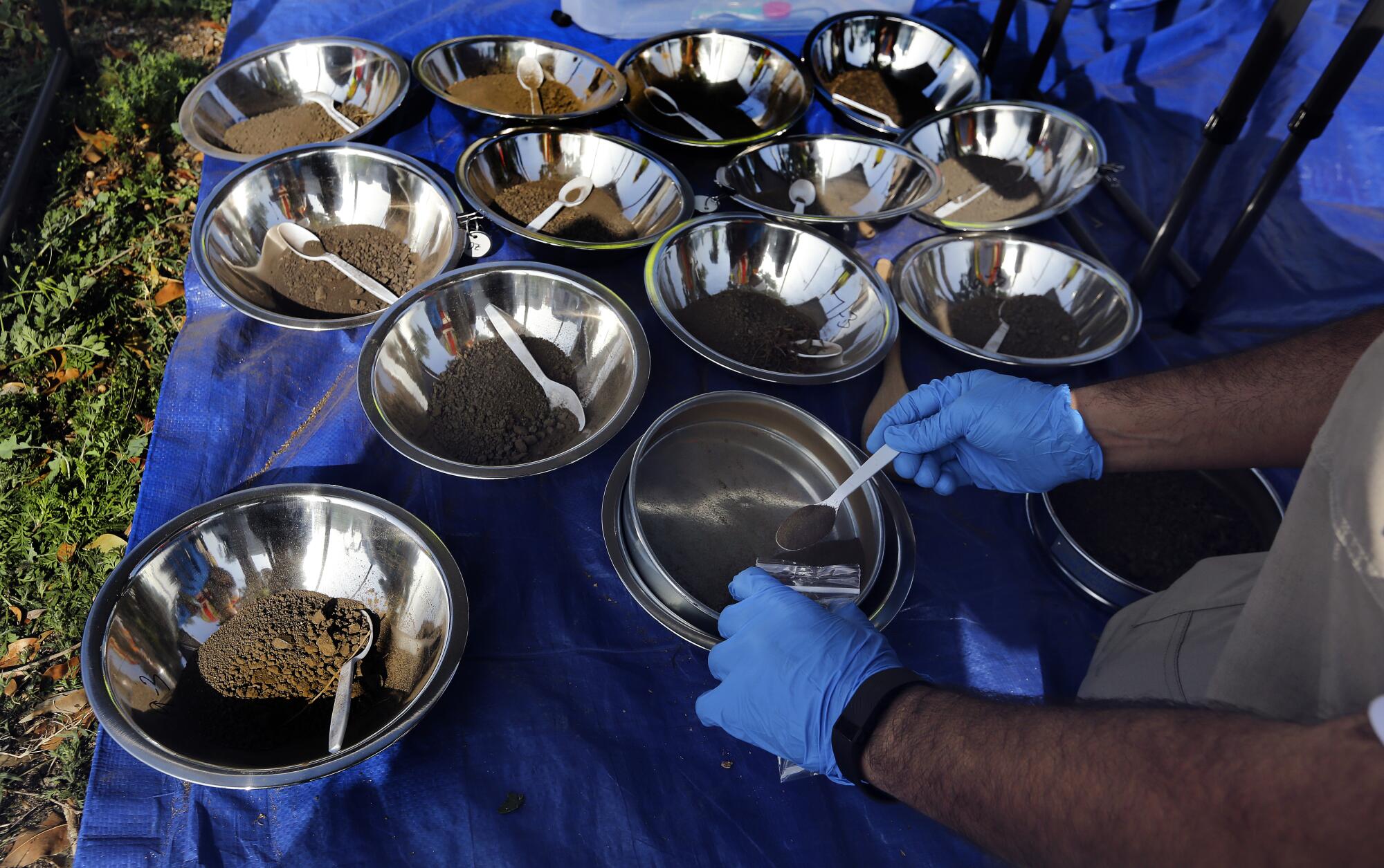
The Times spoke with more than a dozen residents and homeowners of failed cleanups who were unaware that their home had been flagged or that they could request additional information.
“That was never explained,” said Noe Villanueva, who lives with his family on Lanfranco Street in Boyle Heights.
Agency officials said that homeowners were informed when work crews failed to achieve the cleanup goals. Every homeowner, they said, was told they could request a document describing the details of the cleanup of their property.
Want more information on your cleanup?
Request a “Letter of Completion” from DTSC by calling the Exide hotline at (844) 225-3887.
Rafael Martinez Sandoval said he initially was hopeful when work crews showed up to his childhood home on 5th Street in East Los Angeles.
Martinez Sandoval said workers dug out the front, but refused to clean much of the back, saying disturbing soil there could imperil the retaining wall and foundation of another house uphill.
The crew did not want to be responsible for compromising the structural integrity of the neighboring house, according to a worker who spoke with The Times. They also could not move excavating equipment into the backyard due to the steep nature of the property.
Workers told Martinez Sandoval he shouldn’t worry, he said, because the lead content of the soil was “low.”

When Martinez Sandoval asked for copies of the state-led testing for his backyard, the Department of Toxic Substances Control did not respond to his requests, he said.
The department said it provided the homeowner this information on at least three occasions.
In September, Martinez Sandoval invited technicians from USC to test his yard. What they found confirmed his suspicions: Lead concentrations in the backyard were above the state health threshold — measuring 105 parts per million in one location and 116 parts per million in another.
“They are making all this money and not doing the work,” Martinez Sandoval said.
Some current and former employees shared Martinez Sandoval’s opinion that contractors were more intent on moving quickly than on doing a thorough job.

“For them, it’s like, rush, rush, rush,” said Stephanie Dillard, who worked for two of the contractors before she said she was terminated for complaining about procedures. “That’s the whole concept of this project: Get it done fast.”
Contractors disputed the idea that they ever sacrificed quality for speed.
Irvine-based National Engineering & Consulting Group, which has had contracts worth tens of millions of dollars to remediate homes, said in a statement that “neither NEC nor its subcontractors are under any time constraint to complete remediation at any property.”
Hirad Emadi, the president of Innovative Construction Solutions, which cleaned more than 760 homes in 2019 and 2020, said his company “received no direct concerns from homeowners and residents about the level of cleanup on their property” and that no workers ever “formally complained about feeling pressured.”
Regulatory agencies have also found fault with the remediation work.
The Los Angeles County district attorney currently is investigating the alleged illegal dumping of contaminated soil from the Exide cleanup.
Although Southern California landfills are not permitted to accept hazardous waste, Innovative Construction Solutions — a subcontractor for Parsons Environment and Infrastructure Group — admitted to disposing 105 tons of heavily contaminated soil in a Waste Management landfill in Azusa in 2019, posing a threat to groundwater.
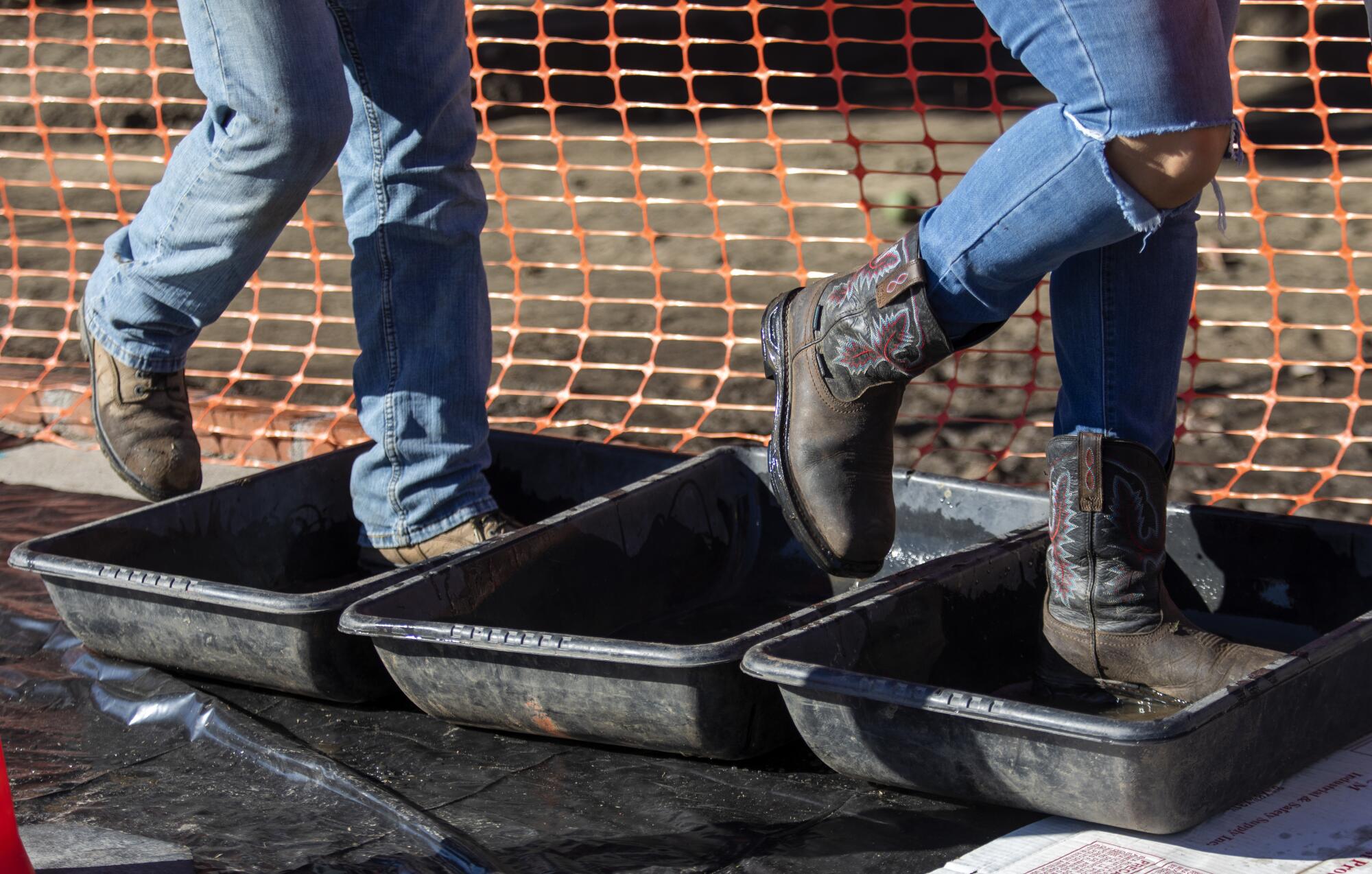
The contractor told the Los Angeles Regional Water Quality Control Board that the soil was dumped in the landfill by mistake and has since removed it at its own expense. Bettahar, of the toxics agency, said new protocols have been put in place to ensure highly contaminated soil isn’t disposed of improperly.
In November 2020, the South Coast Air Quality Management District cited National Engineering & Consulting and its subcontractor American Integrated Services for stockpiling contaminated soil on the same block as a preschool in Huntington Park without putting up proper signage to warn the public.
The two companies were cited at least twice more for failing to prevent toxic dust emissions from crossing property lines, including once for failing to adequately wet soil or use a dust suppressant before loading the soil up for disposal.
They also were cited in a separate instance for failing to remove excess soil in roadways at the end of the workday.
National Engineering & Consulting said the violations were corrected.
Many of the violations and complaints are directed at subcontractors. Department of Toxic Substances Control officials said they do not involve themselves in the hiring of those companies.
Cleanup lapses go beyond residents’ yards. Six years in, there is still no plan for removing some of the most contaminated soil in the neighborhoods — the strips of land between sidewalks and the street.
The danger was highlighted in 2018, when county health officials traced a child’s poisoning to a dog tracking leaded soil from a nearby parkway into the house.
A year after that, department officials compiled and posted data showing that parkways contained alarmingly high levels of lead. The toxics agency collected more than 8,100 soil samples, and testing revealed 76% contained lead levels higher than the California safety threshold.
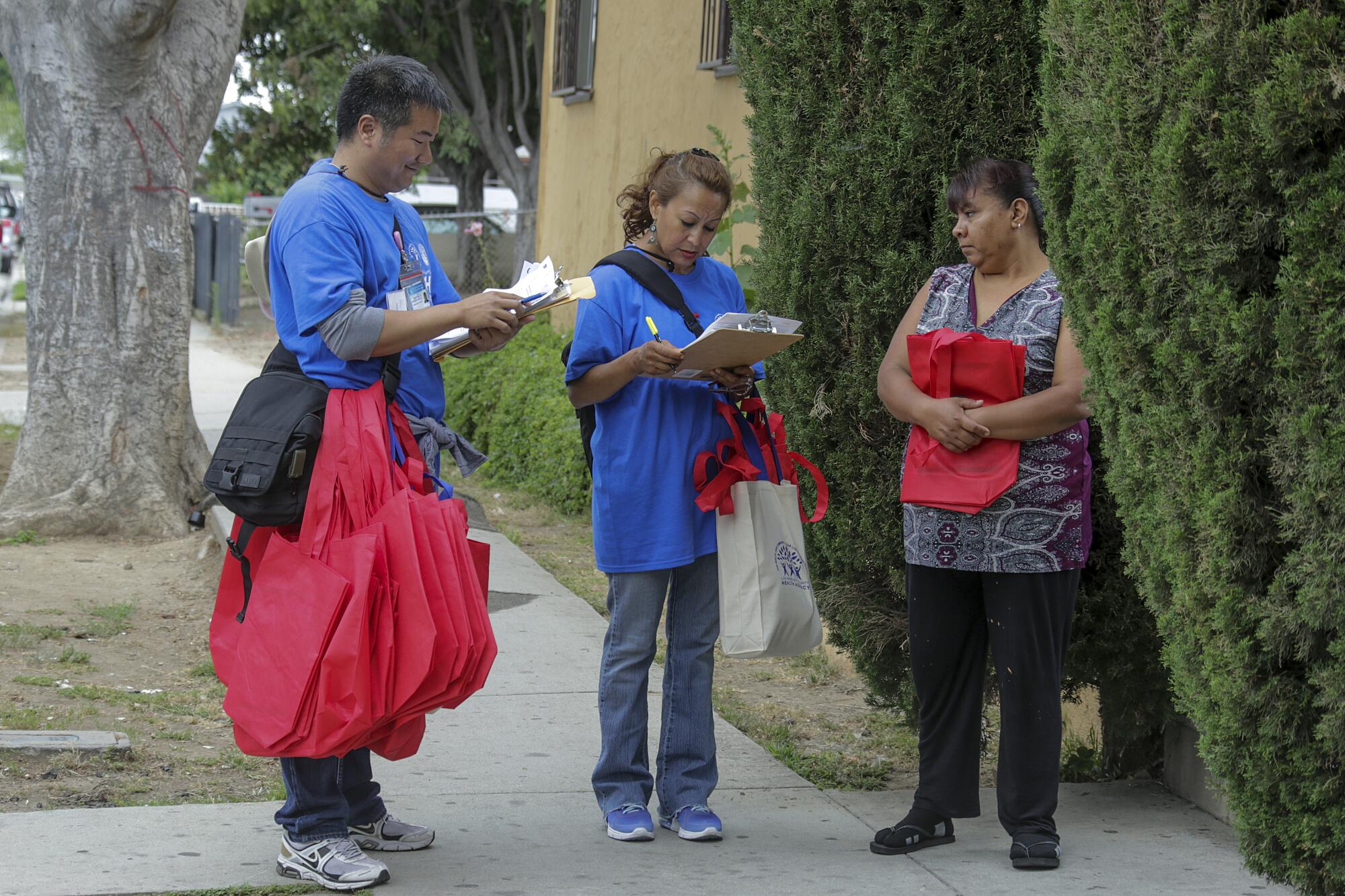
The highest concentration, 13,900 parts per million, was discovered outside of a home in the city of Bell. Unsafe levels were also detected outside parks and near schools, including two samples containing concentrations of more than 2,000 parts per million, directly outside of Lou Costello Jr. Recreation Center, a Los Angeles park with two baseball diamonds and a playground.
Years later, they are still not being cleaned — even after the department conducted its own survey and found that more than 30% of residents with children reported their kids played in or otherwise made contact with a parkway at least once a week, and nearly 10% said their children did so every day.
Williams, the agency director, said it has not received enough funding to clean the parkways.
But Assemblyman Miguel Santiago (D-Los Angeles), who authored legislation in 2018 to set aside money for testing and cleaning, said he was dumbfounded and enraged to learn from The Times that the work remained uncompleted.
“I’m at a loss for words,” he said. “That is outrageous.” He added that the legislature has “appropriated hundreds of millions of dollars” on the cleanup and “if that wasn’t enough, then say something.”
“These are people’s lives at stake. These are children’s lives in our neighborhood” he added. “This community deserves better.”
Many critics say failure to address the parkways is just one example of how the state’s cleanup approach was flawed from the start.
The state decided to prioritize properties with the highest concentrations of lead, a strategy designed to protect residents at highest risk of exposure.

But this approach prompted crews to hopscotch around the cleanup zone — house by house — removing lead from some properties and not others.
On any given block, clean properties sat next to contaminated ones, in some cases for years. Community members said that cleanup approach would allow wind, foot traffic or storm runoff to spread lead contamination to cleaned properties.
The state dismissed those concerns. Remaining properties would have less lead and be less likely to cause re-contamination, they said.
mark! Lopez, a community organizer for East Yard Communities for Environmental Justice, said the approach made no sense.
“You don’t sweep your house tile by tile, right? You don’t sweep this tile and then walk 50 feet over and sweep that tile — then come back two days later and sweep another one.”
Dr. Cyrus Rangan, director of the Los Angeles County Department of Public Health’s Bureau of Toxicology and Environmental Assessment, said authorities in that office questioned the approach.
“If you have a house where you uncovered 1,000 parts per million of lead, you should assume all homes have those levels and avoid having to test all homes on that block. ... You should clean block by block.”
Williams said the agency stands behind its decision to prioritize the most contaminated properties. State funding was doled out in phases, without the guarantee that more money would be approved. Consequently, the department dispatched cleanup crews to properties with the highest levels of lead, and to sensitive areas such as schools, day care centers and parks.
For generations, Boyle Heights and East Los Angeles have served as the gravitational center for Mexican culture in Southern California, marked by grand murals of Cesar Chavez, the triumphant blare of trumpets in Mariachi Plaza and vibrant corridors of street vendors.
Many households are multi-generational, with grandmothers, uncles and children all living under the same roof. It’s also an area where life is often enjoyed at backyard cookouts, amid lush home gardens and in neighborhood parks.
Community members who are aware of the dangers of lead have had to sacrifice some simple pleasures. They’ve paved over potentially contaminated open soil, leaving yards devoid of green space. They’ve stopped eating the fruit from their trees and from community gardens, worried about what it might contain.
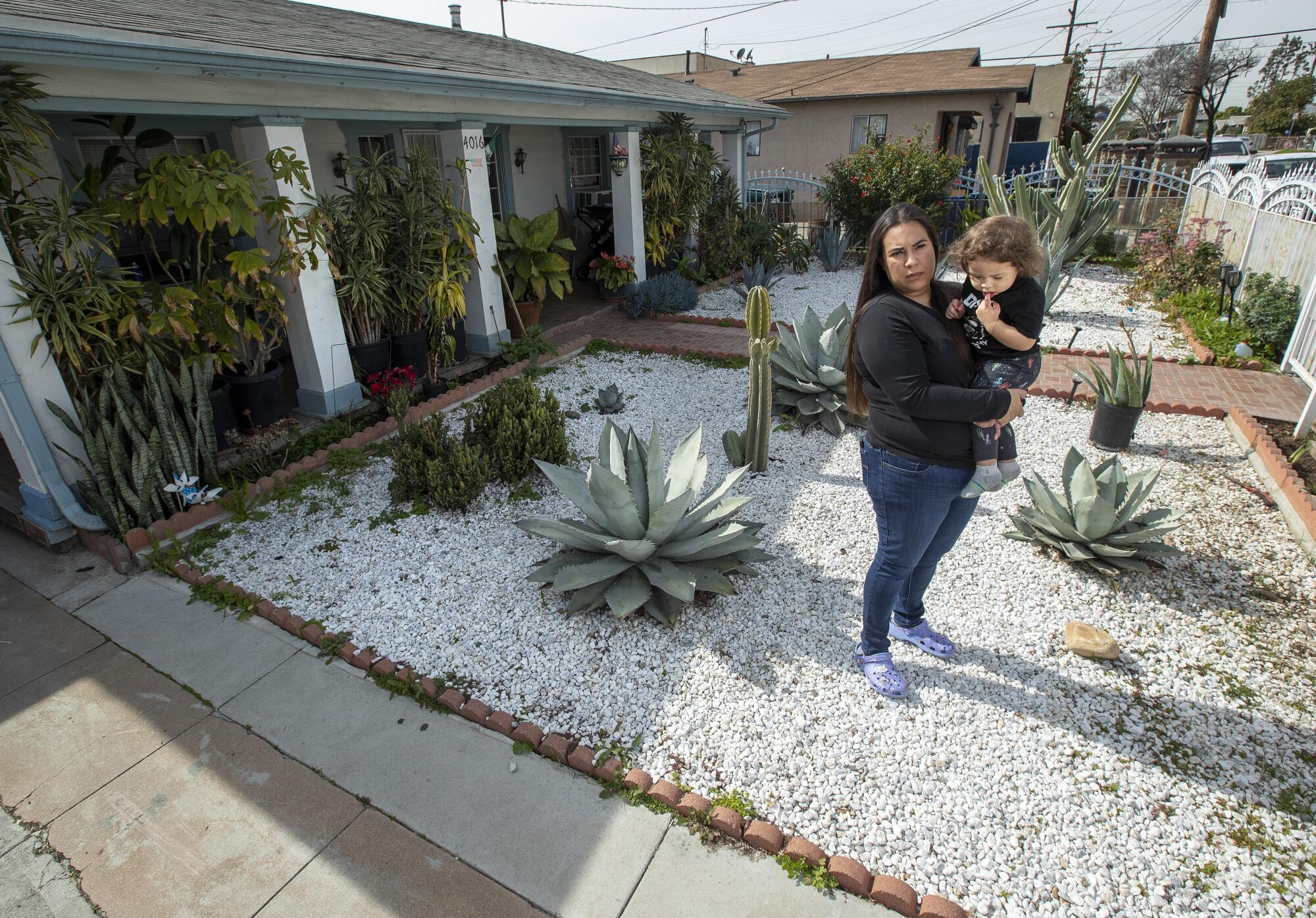
Valdovinos has never wanted to leave her neighborhood. Yet she’s frightened of what might happen if she stays.
Her daughter’s speech was delayed as a toddler; she is closely monitoring her son.
In August, Valdovinos’ mother, an avid gardener who cared for the home’s pomegranate and guava trees, died after a sudden and aggressive bout with sarcoma. Since her death, the one-story home on Percy Street has become their last connection to her.
Although Valdovinos knows her father and brother will stay, she has decided, as a mother herself now, she must leave to protect her children.
- Share via
Watch L.A. Times Today at 7 p.m. on Spectrum News 1 on Channel 1 or live stream on the Spectrum News App. Palos Verdes Peninsula and Orange County viewers can watch on Cox Systems on channel 99.
More to Read
Sign up for Essential California
The most important California stories and recommendations in your inbox every morning.
You may occasionally receive promotional content from the Los Angeles Times.
